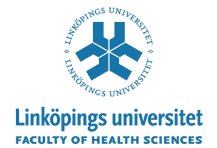 |
Visa svensk kursplan |
|
COURSE CATEGORY Single subject course MAIN FIELD OF STUDY SUBJECT AREA |
COURSE CODE | 8FA026 |
Learning Outcomes
By the end of the course the students will be able to:
-Apply an advanced knowledge of the mechanisms of drug action to analyse drug effects on a molecular to medical level
-Analyse advanced models of drug/receptor protein interactions
-Analyse complex relationships between drug concentration and medical effects
-Apply the knowledge to design and perform laboratory studies in the area of pharmacodynamic sciences
-Evaluate and analyse complex pharmacodynamic problems presented in the scientific literature and argue for the opinion in oral or written presentations
-Drugs that interact with transmembrane proteins (e.g. receptor proteins, ion-channels, cell adhesion molecules, carriers and enzymes)
-Drugs that interfere with intracellular target proteins (e.g. enzymes, steroid receptors and cytoskeletal proteins) and with replication, transcription and translation.
-Current concept of drug/receptor protein interaction
-Drugs that affect the neuron and neurotransmission including cholinergic, adrenergic and peptidnergic transmission
-Drugs that affect muscle cells
-Principles of gene- and immunotherapy
-Overview of pharmacokinetics (drug absorption, distribution and elimination) and therapeutics
-Recent research within some field of pharmacology and on modern techniques available to study and elucidate the molecular and cellular basis of how drugs act
The educational method used is problem-based learning (PBL). PBL emphasises the student´s development of free, self-supporting, lifelong learning ability as an instrument for critical inquiry. The student´s own queries and the problems formulated form the basis of PBL. What is also important is the student´s ability to take responsibility for his/her own learning, and to seek and evaulate information and knowledge as well as to develop co-operative skills and a flexible attitude to different views and ideas.
Students who have failed the course or part of the course twice are entitled to request another examiner for the following examination occasion.
Extent of re-examinations
The extent of a re-examination shall be similar to the regular examination.
Entries for examinations
Rules for entries for examination are given in the course plan. In addition the "Regulations regarding examinations and examiners" laid down by decision of Linköpings University (Dnr LiU 1109/00-40) apply.
Applicants with a degree from a non-Swedish university must enclose an official examination certificate of at least three years of full-time studies in subjects with relevance for Life Science, such as biology, chemistry, medicine or the like.
Documented knowledge of English equivalent to ”Engelska B”; i.e. English as native language or an internationally recognized test, e.g. TOEFL (miminum scores: Paperbased 550 + TWE-score 4.0, computerbased 213 and internetbased 79), IELTS, academic (minimum score: Overall band 6.0 and no band under 5.0), or equivalent.
Planning and implementation of the course shall be carried out on the basis of the wording in this course plan. The evaluation of the course should therefore consider the question how well the course agrees with the course plan.
An anonymous written individual evaluation at the end of the course is supplemented with oral evaluations in group. Electronic evaluation of the course will also take place in accordance with Linköping University´s regulations (Dnr LiU 780/06-04).
Certificate
At the student´s request, course certificate may be issued by the director of studies for courses or, according to delegation, by the head of the department/director of programme studies.
Additional Information
The course is given in such a way that both men´s and women´s experiences and knowledge are made visible and developed.
If the course is withdrawn, or is subject to major changes, examinations according to this course plan are normally offered on a total of three occations within one year, one of them in close connection with the first examination.
|
||||||||||||||||||||||||||||||||||||||||||||||||||||||||||||||||||||||||||||||